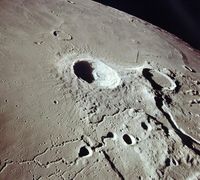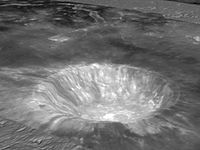
Aristarchus (crater)
About this schools Wikipedia selection
SOS Children have produced a selection of wikipedia articles for schools since 2005. SOS Children is the world's largest charity giving orphaned and abandoned children the chance of family life.
 Aristarchus (centre) and Herodotus (right) from Apollo 15. NASA photo. |
|
| Coordinates | 23.7°N 47.4°W Coordinates: 23.7°N 47.4°W |
|---|---|
| Diameter | 40 km |
| Depth | 3.7 km |
| Colongitude | 48° at sunrise |
| Eponym | Aristarchus of Samos |
Aristarchus is a prominent lunar impact crater that lies in the northwest part of the Moon's near side. It is considered the brightest of the large formations on the lunar surface, with an albedo nearly double that of most lunar features. The feature is bright enough to be visible to the naked eye, and is dazzling in a large telescope. It is also readily identified when most of the lunar surface is illuminated by earthshine.
The crater is located at the southeastern edge of the Aristarchus plateau, an elevated area that contains a number of volcanic features, such as sinuous rilles. This area is also noted for the large number of reported transient lunar phenomena, as well as recent emissions of radon gas as measured by the Lunar Prospector spacecraft.
Aristarchus was originally named after the Greek astronomer Aristarchus of Samos by the Italian map maker Giovanni Riccioli. His work Almagestum novum ("New Almagest"), published in 1651, gave the spot-shaped telescopic features (later called craters) eponyms of noted astronomers and philosophers. Although it was already widely adopted, the name didn't become an official international standard until a vote by the IAU General Assembly in 1935.
Selenography
The Aristarchus crater is located on an elevated rocky rise, known as the Aristarchus plateau, in the midst of the Oceanus Procellarum, a large expanse of lunar mare. This is a tilted crustal block, about 200 km across, that rises to a maximum altitude of 2 km above the mare in the southeastern section. Aristarchus crater is just to the east of the Herodotus crater and the Vallis Schröteri, and south of a system of narrow sinuous rilles named Rimae Aristarchus.
The main reason for the crater's brightness is that it is a young formation, approximately 450 million years old, and the solar wind has not yet had time to darken the excavated material by the process of space weathering. The impact occurred following the creation of the Copernicus crater, but before the appearance of Tycho crater.
The brightest feature of this crater is the steep central peak. Sections of the interior floor appear relatively level, but Lunar Orbiter photographs reveal the surface is covered in many small hills, streaky gouges, and some minor fractures. The crater has a terraced outer wall, roughly or polygonal in shape, and covered in a bright blanket of ejecta. These spreads out into bright rays to the south and south-east, suggesting that Aristarchus was most likely formed by an oblique impact from the northeast, and their composition includes material from both the Aristarchus plateau and the lunar mare.
Remote sensing
In 1911, Professor Robert W. Wood used ultraviolet photography to take images of the crater area. He discovered the plateau had an anomalous appearance in the ultraviolet, and an area to the north appeared to give indications of a sulfur deposit. This colorful area is sometimes referred to as "Wood's Spot", an alternate name for the Aristarchus Plateau.

Spectra taken of this crater during the Clementine mission were used to perform mineral mapping. The data indicated that the central peak is a type of rock called anorthosite, which is a slow-cooling form of igneous rock composed of plagioclase feldspar. By contrast the outer wall is troctolite, a rock composed of equal parts plagioclase and olivine.
The Aristarchus crater region was part of a Hubble space telescope study in 2005 that was investigating the presence of oxygen-rich glassy soils in the form of the mineral ilmenite. Baseline measurements were made of the Apollo 15 and Apollo 17 landing sites, where the chemistry is known, and these were compared to Aristarchus. The Hubble Advanced Camera for Surveys was used to photograph the crater in visual and ultraviolet light. The crater was determined to have especially rich concentrations of ilmenite, a titanium oxide mineral that could potentially be used in the future by a lunar settlement for extracting oxygen.
Transient lunar phenomena
The region of the Aristarchus plateau has been the site of many reported transient lunar phenomena. Such events include temporary obscurations and colorations of the surface, and catalogues of these show that more than one-third of the most reliable spottings come from this locale. In 1971 when Apollo 15 passed 110 kilometers above the Aristarchus plateau, a significant rise in alpha particles was detected. These particles are believed to be caused by the decay of radon-222, a radioactive gas with a half-life of only 3.8 days. The Lunar Prospector mission later confirmed Radon-222 emissions from this crater. These observations could be explained by either the slow and visually imperceptible diffusion of gas to the surface, or by discrete explosive events.
Satellite craters
Surrounding the Aristarchus crater are several smaller craters, many of which are probably " secondary craters". Secondary craters form when large blocks ejected from the primary crater reimpact the surface at high velocities. By convention these features are identified on lunar maps by placing a letter on the side of the crater mid-point that is closest to the primary crater.
| Aristarchus | Latitude | Longitude | Diameter |
|---|---|---|---|
| B | 26.3° N | 46.8° W | 7 km |
| D | 23.7° N | 42.9° W | 5 km |
| F | 21.7° N | 46.5° W | 18 km |
| H | 22.6° N | 45.7° W | 4 km |
| N | 22.8° N | 42.9° W | 3 km |
| S | 19.3° N | 46.2° W | 4 km |
| T | 19.6° N | 46.4° W | 4 km |
| U | 19.7° N | 48.6° W | 4 km |
| Z | 25.5° N | 48.4° W | 8 km |
The following craters have been renamed by the IAU.
- Aristarchus A — See Väisälä crater.
- Aristarchus C — See Toscanelli crater.
